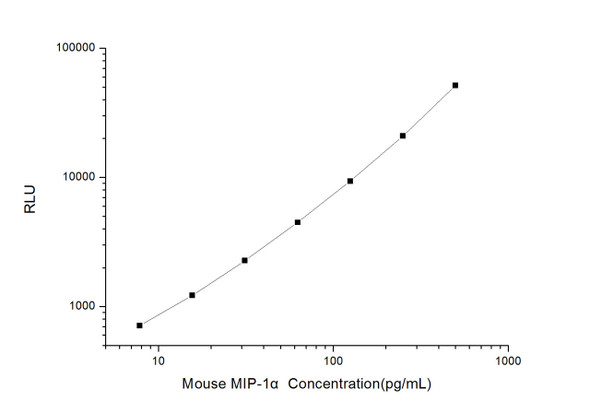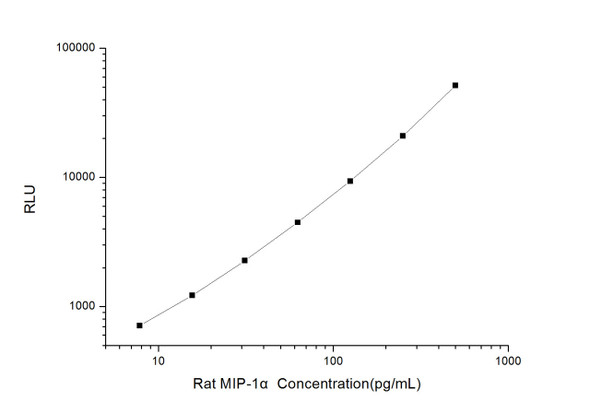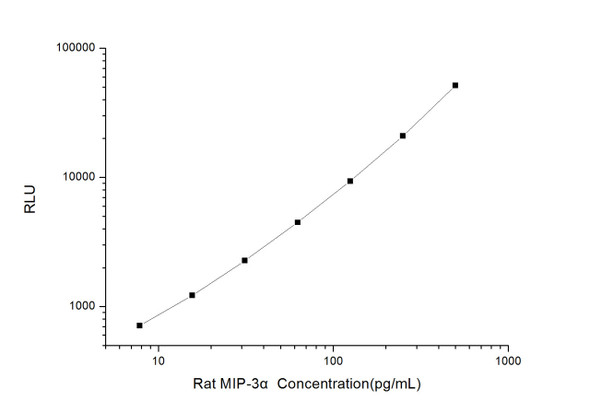Human Cell Biology ELISA Kits 3
Human MIP-1 alpha (Macrophage Inflammatory Protein 1 Alpha) CLIA Kit (HUES00021)
- SKU:
- HUES00021
- Product Type:
- ELISA Kit
- ELISA Type:
- CLIA Kit
- Size:
- 96 Assays
- Sensitivity:
- 7.5pg/mL
- Range:
- 12.5-800pg/mL
- ELISA Type:
- Sandwich
- Synonyms:
- CCL3, LD78ALPHA, MIP-1-alpha, MIP1A, SCYA3, G0S19-1
- Reactivity:
- Human
- Sample Type:
- Serum, plasma and other biological fluids
- Research Area:
- Cell Biology
Description
| Assay type: | Sandwich |
| Format: | 96T |
| Assay time: | 4.5h |
| Reactivity: | Human |
| Detection method: | Chemiluminescence |
| Detection range: | 12.50-800 pg/mL |
| Sensitivity: | 7.50 pg/mL |
| Sample volume: | 100µL |
| Sample type: | Serum, plasma and other biological fluids |
| Repeatability: | CV < 15% |
| Specificity: | This kit recognizes Human MIP-1 alpha in samples. No significant cross-reactivity or interference between Human MIP-1 alpha and analogues was observed. |
This kit uses Sandwich-CLIA as the method. The micro CLIA plate provided in this kit has been pre-coated with an antibody specific to Human MIP-1 alpha. Standards or samples are added to the appropriate micro CLIA plate wells and combined with the specific antibody. Then a biotinylated detection antibody specific for Human MIP-1 alpha and Avidin-Horseradish Peroxidase (HRP) conjugate are added to each micro plate well successively and incubated. Free components are washed away. The substrate solution is added to each well. Only those wells that contain Human MIP-1 alpha, biotinylated detection antibody and Avidin-HRP conjugate will appear fluorescence. The Relative light unit (RLU) value is measured spectrophotometrically by the Chemiluminescence immunoassay analyzer. The RLU value is positively associated with the concentration of Human MIP-1 alpha. The concentration of Human MIP-1 alpha in the samples can be calculated by comparing the RLU of the samples to the standard curve.
| UniProt Protein Function: | CCL3: Monokine with inflammatory and chemokinetic properties. Binds to CCR1, CCR4 and CCR5. One of the major HIV-suppressive factors produced by CD8+ T-cells. Recombinant MIP-1-alpha induces a dose-dependent inhibition of different strains of HIV-1, HIV-2, and simian immunodeficiency virus (SIV). Belongs to the intercrine beta (chemokine CC) family. |
| UniProt Protein Details: | Protein type:Chemokine; Secreted; Secreted, signal peptide; Motility/polarity/chemotaxis Chromosomal Location of Human Ortholog: 17q12 Cellular Component: extracellular space; cytoplasm; extracellular region; intracellular; cytosol Molecular Function:identical protein binding; CCR1 chemokine receptor binding; protein binding; chemokine activity; calcium-dependent protein kinase C activity; kinase activity; protein kinase activity; CCR5 chemokine receptor binding; chemoattractant activity; phospholipase activator activity Biological Process: positive regulation of catalytic activity; negative regulation of osteoclast differentiation; exocytosis; response to toxin; behavior; positive regulation of calcium-mediated signaling; positive regulation of interleukin-1 beta secretion; chemotaxis; protein amino acid phosphorylation; regulation of cell shape; negative regulation of bone mineralization; monocyte chemotaxis; positive chemotaxis; cell-cell signaling; calcium ion transport; positive regulation of neuron apoptosis; protein kinase B signaling cascade; lipopolysaccharide-mediated signaling pathway; inflammatory response; lymphocyte chemotaxis; neutrophil chemotaxis; MAPKKK cascade; calcium-mediated signaling; cytoskeleton organization and biogenesis; release of sequestered calcium ion by sarcoplasmic reticulum into cytosol; positive regulation of tumor necrosis factor production; macrophage chemotaxis; cellular calcium ion homeostasis; osteoblast differentiation; cell activation; positive regulation of protein kinase B signaling cascade; eosinophil chemotaxis; eosinophil degranulation; regulation of sensory perception of pain; positive regulation of calcium ion transport; astrocyte cell migration; positive regulation of inflammatory response; positive regulation of cell migration Disease: Human Immunodeficiency Virus Type 1, Susceptibility To |
| NCBI Summary: | This locus represents a small inducible cytokine. The encoded protein, also known as macrophage inflammatory protein 1 alpha, plays a role in inflammatory responses through binding to the receptors CCR1, CCR4 and CCR5. Polymorphisms at this locus may be associated with both resistance and susceptibility to infection by human immunodeficiency virus type 1. [provided by RefSeq, Sep 2010] |
| UniProt Code: | P10147 |
| NCBI GenInfo Identifier: | 127078 |
| NCBI Gene ID: | 6348 |
| NCBI Accession: | P10147. 1 |
| UniProt Related Accession: | P10147 |
| Molecular Weight: | 10,085 Da |
| NCBI Full Name: | C-C motif chemokine 3 |
| NCBI Synonym Full Names: | chemokine (C-C motif) ligand 3 |
| NCBI Official Symbol: | CCL3 |
| NCBI Official Synonym Symbols: | MIP1A; SCYA3; G0S19-1; LD78ALPHA; MIP-1-alpha |
| NCBI Protein Information: | C-C motif chemokine 3; SIS-beta; PAT 464. 1; G0/G1 switch regulatory protein 19-1; macrophage inflammatory protein 1-alpha; tonsillar lymphocyte LD78 alpha protein; small inducible cytokine A3 (homologous to mouse Mip-1a) |
| UniProt Protein Name: | C-C motif chemokine 3 |
| UniProt Synonym Protein Names: | G0/G1 switch regulatory protein 19-1; Macrophage inflammatory protein 1-alpha; MIP-1-alpha; PAT 464. 1; SIS-beta; Small-inducible cytokine A3; Tonsillar lymphocyte LD78 alpha proteinCleaved into the following chain:MIP-1-alpha(4-69)Alternative name(s):LD78-alpha(4-69) |
| UniProt Gene Name: | CCL3 |
| UniProt Entry Name: | CCL3_HUMAN |
As the RLU values of the standard curve may vary according to the conditions of the actual assay performance (e. g. operator, pipetting technique, washing technique or temperature effects), the operator should establish a standard curve for each test. Typical standard curve and data is provided below for reference only.
| Concentration (pg/mL) | RLU | Average | Corrected |
| 800 | 49734 55550 | 52642 | 52616 |
| 400 | 21428 22040 | 21734 | 21708 |
| 200 | 10284 9132 | 9708 | 9682 |
| 100 | 4196 4908 | 4552 | 4526 |
| 50 | 2217 2159 | 2188 | 2162 |
| 25 | 1144 976 | 1060 | 1034 |
| 12.50 | 484 534 | 509 | 483 |
| 0 | 25 27 | 26 | -- |
Precision
Intra-assay Precision (Precision within an assay): 3 samples with low, mid range and high level Human MIP-1 alpha were tested 20 times on one plate, respectively.
Inter-assay Precision (Precision between assays): 3 samples with low, mid range and high level Human MIP-1 alpha were tested on 3 different plates, 20 replicates in each plate.
| Intra-assay Precision | Inter-assay Precision | |||||
| Sample | 1 | 2 | 3 | 1 | 2 | 3 |
| n | 20 | 20 | 20 | 20 | 20 | 20 |
| Mean (pg/mL) | 39.20 | 107.86 | 347.92 | 39.81 | 115.66 | 358.19 |
| Standard deviation | 3.39 | 9.71 | 31.52 | 4.94 | 13.61 | 24.29 |
| C V (%) | 8.65 | 9.00 | 9.06 | 12.41 | 11.77 | 6.78 |
Recovery
The recovery of Human MIP-1 alpha spiked at three different levels in samples throughout the range of the assay was evaluated in various matrices.
| Sample Type | Range (%) | Average Recovery (%) |
| Serum (n=5) | 87-98 | 93 |
| EDTA plasma (n=5) | 97-111 | 104 |
| Cell culture media (n=5) | 100-114 | 107 |
Linearity
Samples were spiked with high concentrations of Human MIP-1 alpha and diluted with Reference Standard & Sample Diluent to produce samples with values within the range of the assay.
| Serum (n=5) | EDTA plasma (n=5) | Cell culture media (n=5) | ||
| 1:2 | Range (%) | 87-102 | 93-107 | 102-120 |
| Average (%) | 94 | 101 | 110 | |
| 1:4 | Range (%) | 100-116 | 90-102 | 99-115 |
| Average (%) | 106 | 96 | 106 | |
| 1:8 | Range (%) | 89-101 | 87-100 | 88-103 |
| Average (%) | 95 | 93 | 94 | |
| 1:16 | Range (%) | 85-96 | 87-98 | 87-101 |
| Average (%) | 91 | 92 | 94 |
An unopened kit can be stored at 4°C for 1 month. If the kit is not used within 1 month, store the items separately according to the following conditions once the kit is received.
| Item | Specifications | Storage |
| Micro CLIA Plate(Dismountable) | 8 wells ×12 strips | -20°C, 6 months |
| Reference Standard | 2 vials | |
| Concentrated Biotinylated Detection Ab (100×) | 1 vial, 120 µL | |
| Concentrated HRP Conjugate (100×) | 1 vial, 120 µL | -20°C(shading light), 6 months |
| Reference Standard & Sample Diluent | 1 vial, 20 mL | 4°C, 6 months |
| Biotinylated Detection Ab Diluent | 1 vial, 14 mL | |
| HRP Conjugate Diluent | 1 vial, 14 mL | |
| Concentrated Wash Buffer (25×) | 1 vial, 30 mL | |
| Substrate Reagent A | 1 vial, 5 mL | 4°C (shading light) |
| Substrate Reagent B | 1 vial, 5 mL | 4°C (shading light) |
| Plate Sealer | 5 pieces | |
| Product Description | 1 copy | |
| Certificate of Analysis | 1 copy |
- Set standard, test sample and control (zero) wells on the pre-coated plate and record theirpositions. It is recommended to measure each standard and sample in duplicate. Note: addall solutions to the bottom of the plate wells while avoiding contact with the well walls. Ensuresolutions do not foam when adding to the wells.
- Aliquot 100µl of standard solutions into the standard wells.
- Add 100µl of Sample / Standard dilution buffer into the control (zero) well.
- Add 100µl of properly diluted sample (serum, plasma, tissue homogenates and otherbiological fluids. ) into test sample wells.
- Cover the plate with the sealer provided in the kit and incubate for 90 min at 37°C.
- Aspirate the liquid from each well, do not wash. Immediately add 100µL of BiotinylatedDetection Ab working solution to each well. Cover the plate with a plate seal and gently mix. Incubate for 1 hour at 37°C.
- Aspirate or decant the solution from the plate and add 350µL of wash buffer to each welland incubate for 1-2 minutes at room temperature. Aspirate the solution from each well andclap the plate on absorbent filter paper to dry. Repeat this process 3 times. Note: a microplatewasher can be used in this step and other wash steps.
- Add 100µL of HRP Conjugate working solution to each well. Cover with a plate seal andincubate for 30 min at 37°C.
- Aspirate or decant the solution from each well. Repeat the wash process for five times asconducted in step 7.
- Add 100µL of Substrate mixture solution to each well. Cover with a new plate seal andincubate for no more than 5 min at 37°C. Protect the plate from light.
- Determine the RLU value of each well immediately.






